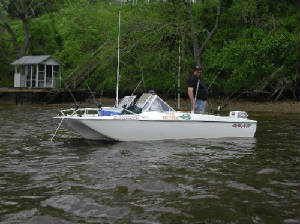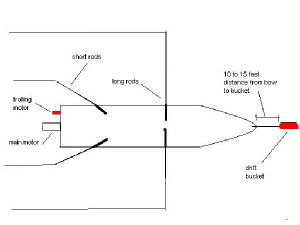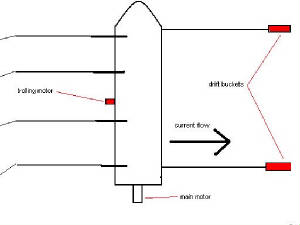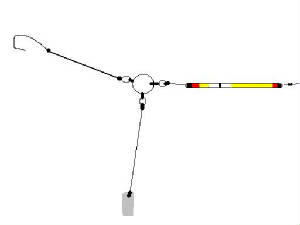|
Instructions Page
Reading water
Most boat fishermen learn out of necessity how to read the water, so as not to run aground or tear their keel out on
a log or wing dam. However most bank fishermen don’t think about reading the water. This is due to limited access to
the water and restrictions as to where they can fish once on the bank. I am going to try to explain some of the things bank
fishermen need to look for so they can make the most of their time on the water.
First lets look at the typical river
bank. Most don’t have much to them, mostly muddy or rocky with little to draw your attention right? Or do they? Let
look. Rule of thumb is what ever the bank looks like is what is under the water for at least 30 yards out. So if the bank
is dirt and mud then the river bottom is mud, and the same holds true with a rocky bank. Now if you see rip rap (large fill
in rocks) then most likely the rip rap will extend only a few yards out. This will help to decide where you want to fish.
You want to look for a gravel or sandy bank with a gentle slope to the water.
Next lets look at the structure
of the bank, is there any thing you see that draws you attention? A blown down tree, a line of old pier posts, or anything
that brakes the bank line into the water. This could be very subtle or drastic. Either will draw small bait fish and this
is what you want to look for. Is there any overhanging limbs from fruit trees? Or capella trees? Anything that will draw insects
or add food to the water. These things will make a small bank opening better to fish, most of the time the best places to
fish are harder to get to than others. Look close at your little section of bank. Even very small things can make it a better
spot than say 50 yards up or down stream, look for these little things and the big things will jump out.
Is this water
effected by tides? If it is then all the better. Go during a full or new moon low tide, this will be the lowest tide of the
month, and look at the water edge, things that are normally under water will be exposed at this time. It is also a good time
to move rocks or brush that would cause hang-ups, don’t remove them just put them to the side of your fishing spot creating
a fish structure for the bait fish. Make sure your local laws allow this first, if it prevents you from making structure then
just move it around to suit your needs. This is also a good time to walk the bank looking for old lost rigs, I do this at
least once a month, you would be surprised how much equipment is lost on a good fishing spot, take a trash bag and clean up
the bank, this makes it much more pleasurable on the next trip, not to mention the tackle you will find. Just finding a few
sinkers will reduce you out of pocket expencies a few dollars.
Next look off the bank a few yards, look at the water
and what it is doing. Water has a personality, it is lazy. Water flows the path of least resistence. That means that anything
in the water stops it’s flow or restricts it. These are what you want to find. There are easiest ones to spot, a rock
sticking up, a tree under the surface, a hole in the bottom, all these things make the surface to different things. These
subtle changes in the surface are what you want to look for. Some things will cause a ripple or hump in the water, others
will cause a fast moving strip of water, others will cause the water to ebb or slack and have a slow moving strip. These chances
in the surface all show a change in the bottom. A hole in the bottom will show a an area of slack
water on the surface, most of the time you can see the size of the hole by the size of the slack water on the surface.
Keep in mind that the flow and current will make the slack area move down from the actual hole, that means that what you see
on top is a little down stream from the spot. So casting to the up side a few yards will but you in the right spot. With obstructions
it is even easier to find, there will be a damming effect that shows on the surface, water will be backing up on the up stream
side and making an eddy on the down stream side. Other obstruction will cause the water to speed up, if they are close to
another obstruction or the obstruction is close to the bank, the water in this area will speed up like pouring water through
a funnel. All these things make fish react in a way to use them to the fishes advantage. Look at the water and how it is acting
and think like a fish, where would you go to eat the most with out fighting the currents and where you can hide from your
prey.
Next is the middle of the river, the channel. All have them and all are different. Some come right to the bank,
some are in the middle, and some are so subtle that they are no more than a drop of a few feet. These can be spotted from
the bank as they will look like a river in the river, the surface of the water will be slicker and normally moving a little
faster. The edge of the is where you want you bait. Most of the time this area will not have many obstructions and will not
hold to many fish unless there is an object there to draw them in, a sunken boat, old car hulk, or a tree hung up on the bottom,
careful though, these can move and change with every hi water time. These obstructions are all fish holding places, however
unless you can pinpoint them with a depth finder then you must rely on the water surface to tell you where they are.
With
every thing listed here you must look and look closely, not all good spots are going to stick out like a tree in the middle
of a field. Most and I mean 90% are hidden. Always get to the water with enough daylight to look at it and study it. After
dark shine a high power light out across the water and look, study to surface. Low tide is best as the small structure will
show and change the way the water acts where at high tide the water will flow over the structure more freely, if your river
does not have tides then you need to observe it over a longer period of time. Low water is best and the mid summer is best
as that is when water is normally lowest. Look for the slightest difference in the surface, a rock or tree or anything on
the bottom will cause a difference in the way the surface looks, the water will have lines of change, watch these lines, they
may be under currents or structure. If it moves then it’s current, fish the edges of these current brakes. If it stays
in the same place then most likely it’s structure of some kind, just remember that you want to fish the down stream
side in a river with current, and also the surface water will be down stream from the structure not right over it.
You
will loose rigs, you will brake off line, you will loose tackle, you will catch fish. All these things will help you to find
a bank hole where you can make the most of you time out on the water.
_
Keep reading
| reading water tell you just where to set up |

|
| click on the picture to add tips in the blog section. |
DRIFT FISHING
FAST
MOVING RIVERS
A drift bucket is used with a trolling motor on a river like the James, a drift anchor is NOT usable
on the James due to the depth and current at different levels of the river. I know you have seen the top water going out and
the baits on the bottom coming back to the boat ageist the flow on top. this is why the drift anchor don't work.
The
lines are off the side, two per side, the one to the front on a long rod the one to the rear a short rod, next the long rod
to the front lays flat and out at 90 deg from the side, the short rod to the rear is up at about 30 deg angle and angled back
at 45 deg to the side, this will allow the baits to stay apart and still drift behind the boat.
Now for the set up
you need for the drift, the bucket goes off the front of the boat and you will have to do trial and error to find the right
set up for the bucket as in, I use a square bucket that kitty litter comes in, my boat needs 4, 1 1/4 holes in the bottom
of the bucket to pull right, your boat might need more or less depending on the size of your boat. The holes in the bottom
allows flow through the bucket to cut drag, a bucket without holes would carry you down current at the same speed of the current.
all you want is enough drag to keep you going down current but less drag so you are not on plane doing it, this is where the
trial and error comes in. you can tie the bucket off to a bow cleat but it might not pull you straight, that is why I have
4 cleats on the bow in different locations to adjust the pull angle for the given current flow on a given day. the bucket
will not work unless it's at least 10 feet out in front of the boat, I find a hole to drift then ANCHOR up from the rear of
the boat on the top of the hole (depending on the direction of the current) and deploy the bucket, this will swing the boat
bow down current, when the pull is good I deploy the fishing lines. I let them set up and straighten them out to set where
I want them too.
Now this is where the trolling motor comes in, I have a clamp on transom mount trolling motor so
it's a little different for me, but you now deploy the trolling motor, you want to pull ageist the drift bucket to keep the
speed of the drift down, I would recommend a transom mount motor since it seems to work better than a bow mount for this set
up. of corse you could just do all this in reverse order and put the bucket off the back and then fish to the front of the
boat, a little backsword but I have seen it done on the Rapp this way on bass boats. The object it to use the trolling motor
to keep the boat from drifting back to the bucket, this is another trial and error process with trolling motor speeds and
bucket currents.
Now here is the secret of the drift. the line set up, this is a big tip. this is taken from saltwater
trolling and drifting wrecks for cobia. the main line will have to be heavy, 30#+ I use 50# for this but 30 will work, It
must be mono not super line of any kind, it wont work!!! use a 8 to 10 inch cigar float, the slip float type, (wal-mart) run
the main line through a bobber stop and then the float just like you were setting up for controlled depth fishing. Now tie
on a three way HEAVY swivel, to this tie on 12 inches of 10 to 12 pound test for a sinker line, to this tie a 3oz banana sinker
or bottom bouncing sinker (I have not found a bottom bouncer in 3 oz yet so I use banana sinkers and snip the second eye off
the bottom of it) next tie you hook and leader to the third swivel eye, the hook must be of the normal "J" hook type, also
the bait must be stream lined to keep it in line and not twisting. a khale or circle hook will twist and flop in the current
and not track right for the drift, the drift is too slow to allow the "cat" hooks to act right in the pattern. the hook leader
need not be long just 8 to 12 inches since you want to keep it down, if you want to go higher then a longer leader but short
works better.
Now back to the float, slide the float down to the three way swivel and then slide the bobber stop down
to the float leaving about 2 inches from the top of the float to the stop. This set up allows more movement in the swivel
area and allows the bait to look more natural since you are going for a reaction bite here and not allowing the fish to check
the bait over and taste it you want it to act like a hurt bait fish which means it must move and flutter some. as for the
bait, DON"T CHUNK IT!!! you will need a flat slab for bait here so use a shad side and no heads or tails, hook the bait from
the tail section so it will track behind the hook just like hooking squid just lace it a couple times and make sure it lays
flat. (what you guys don’t use squid? that is the best spring time bait since you flavor it with shad oil or clam oil
in the fridge in a zip lock )
Now, to deploy the lines, start with the short rods off the back first and don't cast
them just let them slide out till you feel the bottom, then go up and set out the long rods off the sides the same way.
Once
this is done pull the anchor and start the drift, the trolling motor will need to be adjusted to keep things in line. I will
not drift short holes since this set up takes time to set up and deploy, I will drift long channels and cuts, the stretch
from 295 bridge to the cut at deep bottom is ideal for this drift. also from Osborne to Dutch gap. the stretch at the pump
house is also a good place, just watch for barges and I recommend all people fishing the James River get a VHF radio, if nothing
but a hand held unit. keep it on channel 13 and the barge captains will keep you informed as to where they are and where they
are going.
Now for the twist, this set up can also be done off the side and side drifting the boat, two buckets deployed
(one front one back) on the same side and a trolling motor on the other side, you will fish the side with the tolling motor
so keeping all things lined up is easier. here again a clamp on trolling motor is a must since you are mounting it on the
gunwale of the boat, this is a very easy method once you get the hang of the drifting.
I know it seems like a lot
to due just to drift a hole but all this takes about 5 min. to set up if the lines are pre rigged and all the equipment is
in place


Tools and Materials
When fishing tidal rivers like the James River here in Virginia, your equipment needs to be strong. I tell everyone
to buy the best equipment you can afford. By doing this you will take out one of the three "lost fish" factors. I’ll
go into detail on that later. For drift fishing, you need strong heavy rods and reels with good drags. Line is the most important
thing in drift fishing, cheep line will not stand up to the structure and cover you will be drifting over. I use Izor line
in 50 lb.test. I find this line to do just the way I like. While the standard three way swivels will work I like the off shore
type in almost any brand. The offshore swivels are mainly black in color and made stronger. the sinker line can be the cheep
stuff as you want it to brake off if hung up. As for the hook leader line, I use nothing but 100lb.test, and the only leader
line you will find on my rigs is Berkley Big Game line. Hooks need to be your personal preference. Almost any hook will catch
catfish but some work better than others.
This rig can be used anytime you want a light bottom
contact

|